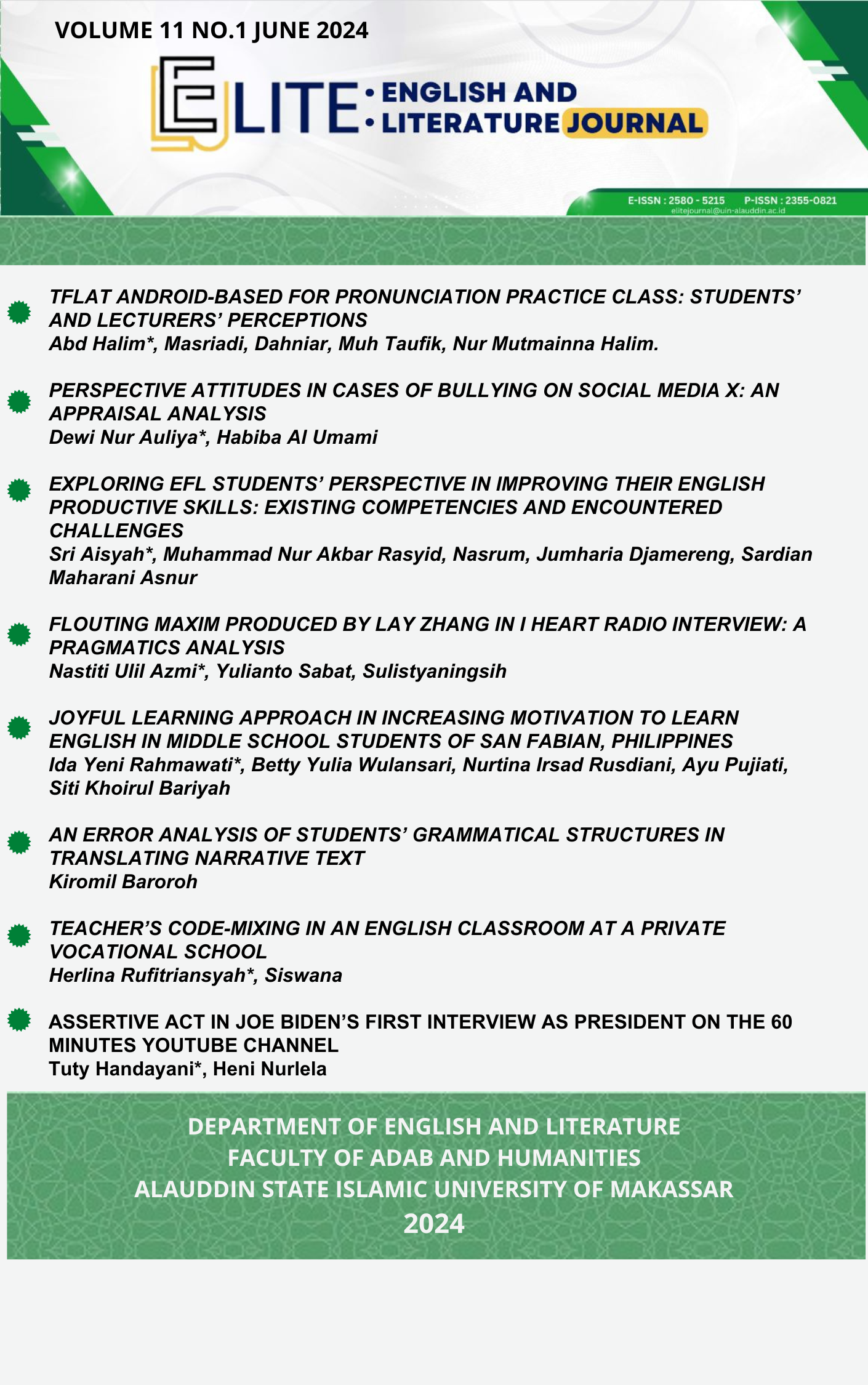ASSERTIVE ACT IN JOE BIDEN’S FIRST INTERVIEW AS PRESIDENT ON THE 60 MINUTES YOUTUBE CHANNEL
Abstract
This research examines the assertive acts employed by Joe Biden during his first interview as President on the 60 Minutes YouTube Channel. Using Searle & Vanderveken’s theory of speech acts, the study adopts a qualitative descriptive approach. Data collection involved watching videos, reading the transcript, and note-taking. The analysis identified 20 utterances which are categorized into eight types of assertive acts: admit, assure, claim, criticize, inform, rebut, report, and predict. The most frequently used of assertive act was “inform”, with 7 utterances, followed by "assure" with 3 utterances. Other acts such as “report”, “predict”, “claim”, and “admit” each appeared twice, while “criticize” and "rebut" were used once each. The study found that all assertive acts, except "criticize," were conveyed directly and literally. In conclusion, Joe Biden conveyed assertive acts by utilizing direct speech and literal meanings to effectively convey his message, particularly in assuring the public of his plans to address the COVID-19 pandemic.
Downloads
References
Abdel-Qader, L. M., & Al-Khanji, R. R. (2022). Conceptual Metaphor in COVID-19 Speeches of the American President Joe Biden. Theory and Practice in Language Studies, 12(4), 810–818. https://doi.org/10.17507/tpls.1204.24
Attamimy, H. F., Junining, E., & Khasanah, I. (2020). Speech Act Analyisis of Jacinda Ardern About Covid-19. Elite English and Literature Journal, 7(2), 209. https://doi.org/10.24252/10.24252/elite.v7i2a9
Cerovac, I. (2020). John Dunn interview. Croatian Journal of Philosophy, 20(59), 133–138.
Chakim, M. A., & Dibdyaningsih, H. (2019). An analysis of teacher speech act in giving motivation for english students. JELTII (Journal of English Language Teaching and Islamic Integration), 2(2), 218–229. https://doi.org/10.31227/osf.io/yzh34
Fitriani, S. S., Achmad, D., & Rasmita, F. (2020). An analysis of illocutionary acts in a fantasy movie. Studies in English Language and Education, 7(1), 170–180. https://doi.org/10.24815/siele.v7i1.13635
Haucsa, G. M., Marzuki, A. G., Alek, A., & Hidayat, D. N. (2020). Illocutionary Speech Acts Analysis in Tom Cruise’S Interview. Academic Journal Perspective : Education, Language, and Literature, 8(1), 11. https://doi.org/10.33603/perspective.v8i1.3304
Ivana, P. S. I., & Suprayogi, S. (2020). the Representation of Iran and United States in Donald Trump’S Speech: a Critical Discourse Analysis. Linguistics and Literature Journal, 1(2), 40–45. https://doi.org/10.33365/llj.v1i2.293
Lambert, V. a., & Lambert, C. E. (2012). Qualitative Descriptive Research: An Acceptable Design. Pacific Rim International Journal of Nursing Research, 16(4), 255–256. http://antispam.kmutt.ac.th/index.php/PRIJNR/article/download/5805/5064
Li, P., & Jeong, H. (2020). The social brain of language: grounding second language learning in social interaction. Npj Science of Learning, 5(1). https://doi.org/10.1038/s41539-020-0068-7
Milal, A. D., & Kusumajanti, W. (2020). Assertive Speech Acts Performed by Teacher in EFL Classes. NOBEL: Journal of Literature and Language Teaching, 11(1), 83–100. https://doi.org/10.15642/nobel.2020.11.1.83-100
Montiel, C. J., Uyheng, J., & Dela Paz, E. (2021). The Language of Pandemic Leaderships: Mapping Political Rhetoric During the COVID-19 Outbreak. Political Psychology, 42(5), 747–766. https://doi.org/10.1111/pops.12753
Pramadya, T. P., & Rahmanhadi, A. D. (2021). A day of history and hope: A critical discourse analysis of Joe Biden’s Inauguration speech. Rainbow : Journal of Literature, Linguistics and Culture Studies, 10(2), 1–10. https://doi.org/10.15294/rainbow.v10i2.45383
Searle, J. R., & Vanderveken, D. (1985). Foundations of Illocutionary Logic (Vol. 21, Issue 3). Cambridge University Press.
Sembiring, W. A., & Ambalegin, A. (2019). Illocutionary Acts on Aladdin Movie 2019. Jurnal Basis, 6(2), 279. https://doi.org/10.33884/basisupb.v6i2.1419
Subandi, Pangesty, H. E., & Wibisono, G. (2020). Illocutionary Acts in Lost in Thailand Detective Humor Movie. Proceedings of the International Joint Conference on Arts and Humanities (IJCAH 2020) Illocutionary, 491(Ijcah), 738–746. https://doi.org/10.2991/assehr.k.201201.124
Tania Caroline, R., Sitorus, U., Sinurat, B., & Silalahi, D. E. (2021). An Analysis on the Speech Act of Mark Zuckerberg in English Speeches YouTube Channel. Zien Journal of Social Sciences and Humanities , 1(1), 175–181. https://zienjournals.com
Vanderveken, D., & Kubo, S. (2002). Essays in speech act theory. Essays in Speech Act Theory, 345. http://books.google.com/books?id=Pa9GzY1A8XUC&pgis=1
Wardana, M. K., Roy, S., & Ariska, J. (2019). Illocutionary Acts in President Rodrigo Duterte’s Speech. International Journal of Culture and Art Studies, 3(1), 40–46. https://doi.org/10.32734/ijcas.v3i1.2514
Yule, G. (1996). Pragmatics by George Yule. In Spain: OUP Oxford. (1st ed.). Oxford University Pres.
Zheni, T. (2020). Functions of Character in Indonesian Folklore Princess of the Runaway Valley: A Study of Vladimir Propp Narrative Structure Theory. International Journal of Language and Literary Studies, 2(4), 215–235. https://doi.org/Received: 51/55/2020 Accepted: 12/12/2020 Keywords: hegemony, illocutionary force, http://doi.org/10.36892/ijlls.v2i2.476 Abstract
Copyright (c) 2024 Tuty Handayani, Heni Nurlela

This work is licensed under a Creative Commons Attribution-NonCommercial-ShareAlike 4.0 International License.
Once an article was published in the journal, the author(s) are:
granted to the journal right licensed under Creative Commons License Attribution that allows others to share the work with an acknowledgement of the work's authorship.
permitted to publish their work online in third parties as it can lead wider dissemination of the work.
continue to be the copyright owner and allow the journal to publish the article with the CC BY-NC-SA 4.0 license
receiving a DOI (Digital Object Identifier) of the work.


